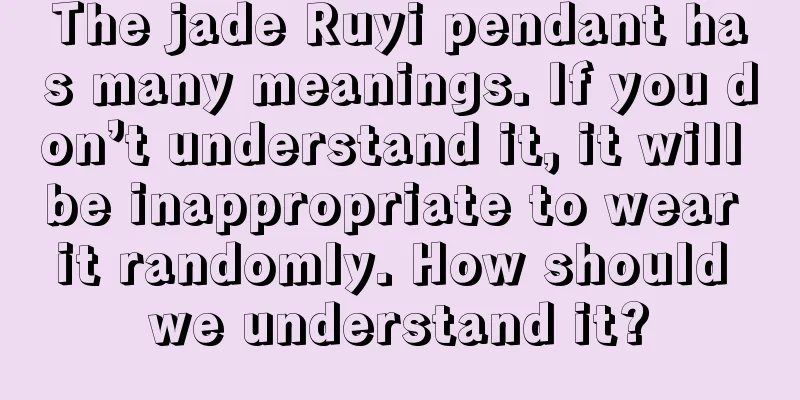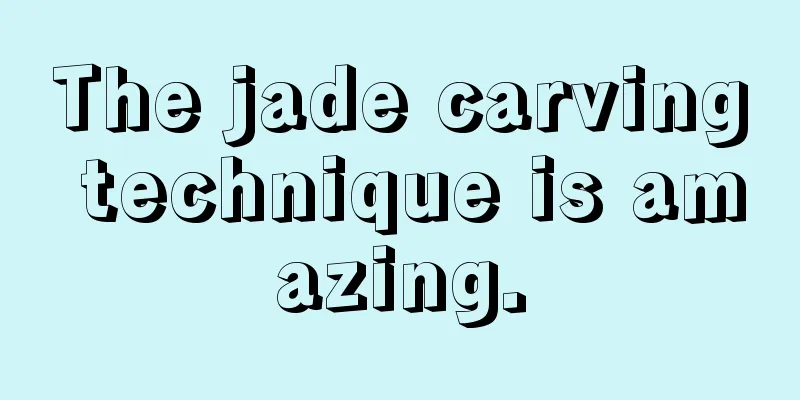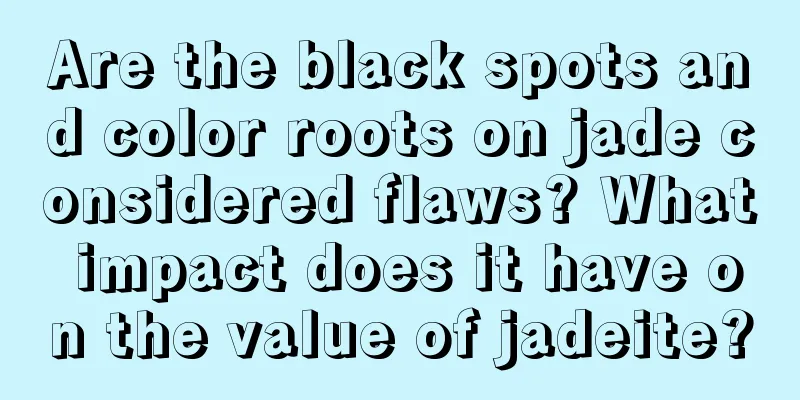What kind of jade is good jade? Don’t fall into the misunderstanding!

|
Jade "The identification of its value has become the focus of investors and collectors. Faced with the wide range of jade markets, many people will be influenced by some "unorthodox methods" and fall into misjudgment. So what are these misconceptions? Let's take a look. Myth 1: The older the jade, the better Many people who collect jade believe that the older the jade is, the higher its value. According to experts, this is not the case. Jadeite is not as ancient as Hetian jade, and its history of development in China is not long. Jade was introduced into China during the Qing Dynasty, and at that time, the Chinese were not very professional in the research of jade, so there was also jade of poor quality. Therefore, sometimes the quality of jadeite that has been passed down from ancient times may not be as good as that of today. Don’t blindly think that jade becomes more valuable as it gets older! Myth 2: Jadeite that does not change color is highly valuable Jade can be divided into three categories: A-grade, B-grade, and C-grade. We know that A-grade is a natural product, B-grade is a semi-finished product, and C-grade is a completely manufactured fake that requires various dyeing and polishing to become a finished jade product. Knowing that inferior jadeite will go through the dyeing process, some people arrogantly believe that jadeite that does not change color for a long time is A-grade jadeite. However, they do not know that some dyed jadeite can maintain its bright color for up to 10 to 20 years. However, some jadeite red or jadeite yellow jadeite may change color in a relatively short period of time, mainly due to changes in the chemical elements inside the jadeite. Jade "The identification of its value has become the focus of investors and collectors. Faced with the wide range of jade markets, many people will be influenced by some "unorthodox methods" and fall into misjudgment. So what are these misconceptions? Let's take a look. Myth 1: The older the jade, the better Many people who collect jade believe that the older the jade is, the higher its value. According to experts, this is not the case. Jadeite is not as ancient as Hetian jade, and its history of development in China is not long. Jade was introduced into China during the Qing Dynasty, and at that time, the Chinese were not very professional in the research of jade, so there was also jade of poor quality. Therefore, sometimes the quality of jadeite that has been passed down from ancient times may not be as good as that of today. Don’t blindly think that jade becomes more valuable as it gets older! Myth 2: Jadeite that does not change color is highly valuable Jade can be divided into three categories: A-grade, B-grade, and C-grade. We know that A-grade is a natural product, B-grade is a semi-finished product, and C-grade is a completely manufactured fake that requires various dyeing and polishing to become a finished jade product. Knowing that inferior jadeite will go through the dyeing process, some people arrogantly believe that jadeite that does not change color for a long time is A-grade jadeite. However, they do not know that some dyed jadeite can maintain its bright color for up to 10 to 20 years. However, some jadeite red or jadeite yellow jadeite may change color in a relatively short period of time, mainly due to changes in the chemical elements inside the jadeite. Myth 3: Green jadeite is the most valuable Perhaps influenced by China's long-term cultural factors, Chinese people prefer green or red jade when choosing jade, among which green jade is definitely the most popular style. However, don’t associate popularity with value. There are many varieties of jade, and many of them are very valuable, such as the top-quality white glass jade. So don’t think that only green jade is good jade. You must correct this concept. Myth 4: The value of craftsmanship is above all else With the development of social economy and culture, people are paying more and more attention to the pursuit of beauty, and they will be attracted by any exquisite work. This mentality has led some jade collectors to develop a misunderstanding, that is, they overemphasize the expressiveness of craftsmanship and ignore the original value of jade. They always believe that as long as the craftsmanship is good, it must be worth a lot. Although the editor is reluctant to reveal the facts, in order to save more "newbies", he still has to explain that the key factor that determines the value of jade is its texture. Jade with good quality has high value, and the later processing only adds added value to it. If it is just a casual piece of jade, even if it has perfect craftsmanship, there will not be much room for appreciation in value if it is collected. Myth 5: The rarer the item, the more valuable it is Natural minerals sometimes form very special patterns. For example, some minerals are arranged in shapes similar to animals or mountains and rivers. Some collectors often hype this kind of jade as a rare treasure. In fact, in addition to being rare, this kind of jade must conform to aesthetic principles and have good texture to be truly "valuable". Misconception 6: Paper Talk. Director Cao of Guangdong Jewelry, Jade and Precious Metals Testing Center introduced that jade optimization processing technology is changing with each passing day, while the knowledge in books often lags behind. If you buy B-grade or fake products by following the identification methods in a book, it may be because the market has invented a new processing technology that has not yet been summarized and published in a book. Isn’t there a saying that goes, It’s better to have no books than to believe in all books! Remember to apply what you have learned flexibly, combine theory with practice, and constantly improve your professional judgment. Myth 7: The more uniform the color, the better In the market, you can often see some jadeite that is emerald green all over, with bright color and very even distribution. In fact, most of such jadeite is fake. The interior of jade is composed of granular minerals, so its green color is locally distributed, and there is a boundary between green and non-green. Myth 3: Green jadeite is the most valuable Perhaps influenced by China's long-term cultural factors, Chinese people prefer green or red jade when choosing jade, among which green jade is definitely the most popular style. However, don’t associate popularity with value. There are many varieties of jade, and many of them are very valuable, such as the top-quality white glass jade. So don’t think that only green jade is good jade. You must correct this concept. Myth 4: The value of craftsmanship is above all else With the development of social economy and culture, people are paying more and more attention to the pursuit of beauty, and they will be attracted by any exquisite work. This mentality has led some jade collectors to develop a misunderstanding, that is, they overemphasize the expressiveness of craftsmanship and ignore the original value of jade. They always believe that as long as the craftsmanship is good, it must be worth a lot. Although the editor is reluctant to reveal the facts, in order to save more "newbies", he still has to explain that the key factor that determines the value of jade is its texture. Jade with good quality has high value, and the later processing only adds added value to it. If it is just a casual piece of jade, even if it has perfect craftsmanship, there will not be much room for appreciation in value if it is collected. Myth 5: The rarer the item, the more valuable it is Natural minerals sometimes form very special patterns. For example, some minerals are arranged in shapes similar to animals or mountains and rivers. Some collectors often hype this kind of jade as a rare treasure. In fact, in addition to being rare, this kind of jade must conform to aesthetic principles and have good texture to be truly "valuable". Misconception 6: Paper Talk. Director Cao of Guangdong Jewelry, Jade and Precious Metals Testing Center introduced that jade optimization processing technology is changing with each passing day, while the knowledge in books often lags behind. If you buy B-grade or fake products by following the identification methods in a book, it may be because the market has invented a new processing technology that has not yet been summarized and published in a book. Isn’t there a saying that goes, It’s better to have no books than to believe in them blindly? Remember to apply what you have learned flexibly, combine theory with practice, and constantly improve your professional judgment. Myth 7: The more uniform the color, the better In the market, you can often see some jadeite that is emerald green all over, with bright color and very even distribution. In fact, most of such jadeite is fake. The interior of jade is composed of granular minerals, so its green color is locally distributed, and there is a boundary between green and non-green.
fruit fcgc33 |
<<: Good jadeite must have both good appearance and good quality.
>>: Come and enjoy the food, Master Zou Wantong's Jade Seafood Feast
Recommend
Beauty that transcends time and space: jadeite from the Qing Dynasty in the National Palace Museum in Taipei, each one is a priceless treasure
The National Palace Museum in Taipei has a collec...
How to identify B-grade jadeite with the naked eye, I really learned it after watching it
To identify B-grade jadeite, you can carefully ob...
Jade carving techniques are magnificent
The Chinese discovered the beauty and value of ja...
For jade figure carvings, what is the difference between 200 and 20,000 yuan?
No matter how good the jadeite raw stone is, if i...
Beautiful hand-painted | Phoenix and butterflies dancing, a beautiful lady playing the flute
The birth of each piece of jade, All of them are ...
Pay attention to these four points when buying jadeite, and no one will dare to say you are a jadeite novice
When purchasing jadeite, some jadeite players who...
The difference between real jade and fake jade, I will tell you today
Want to buy jadeite, but don’t know where to star...
How to “maintain” a piece of jade? 8 steps to make your jade more and more smooth!
It is said that "people take care of jade fo...
Even the jade carving masters could not imagine the colored jadeite flakes, which are so attractive after being unearthed
Today I’d like to share with you the production p...
Emerald, absolutely beautiful
I fell in love with jade, I don’t know when it st...
Why can’t I just get the jade? Three reasons you should know
As we all know, different industries have differe...
Jade Appreciation | Jadeite bracelets from the Taipei National Palace Museum, each one is stunning
Ji Yun once wrote in his Notes from the Yuewei Th...
“Wherever a dragon goes, there is water.” Cutting such a raw stone is really thrilling! ! !
Dragonstones have always been objects that live i...
What does Jade Blue Water Type mean? What kind of blue water jade is good?
There are many ways to classify jade, and there a...
How can we tell the authenticity of jadeite with the naked eye?
Because the jade industry is not very transparent...









